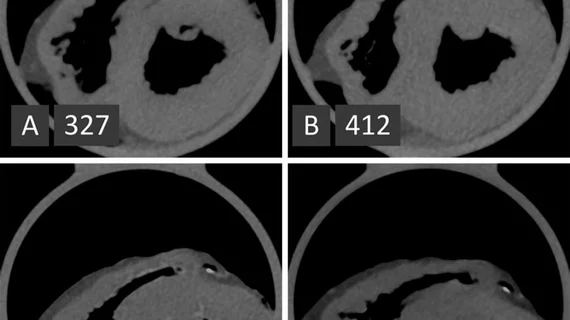Coronary artery calcium (CAC) scoring could be the key to determining which patients are most likely to benefit from statin therapy, according to a retrospective analysis published Nov. 5 in the Journal of the American College of Cardiology.
Patients without any CAC derived no significant benefit from statins, while those with CAC scores above 100 showed the biggest reductions in major adverse cardiovascular events (MACE) including stroke, myocardial infarction and cardiovascular death associated with the cholesterol-lowering drugs.
“Many have argued for the potential use of CAC to help identify patients with increased benefit from statins and improve shared decision making, although lack of direct data showing the utility of CAC in selecting patients for statin treatment has prevented widespread use or a stronger recommendation in clinical guidelines,” wrote lead author Joshua D. Mitchell, MD, with Washington University School of Medicine in St. Louis, and colleagues. “Our study helps provide valuable information on the effect of statin therapy in a real-world population without known ASCVD (atherosclerotic cardiovascular disease) who underwent CAC scoring.”
The analysis included 13,644 patients who had CAC scoring at Walter Reed Army Medical Center in Washington, D.C., from 2002 to 2009. Patients were 71 percent men and 50 years old on average at baseline, and were followed for a median 9.4 years.
Among patients who had atherosclerotic plaque detected upon CT, any statin use over the ensuing five years was associated with a 24 percent reduced risk of MACE during follow-up. However, individuals with zero CAC showed no risk reduction with statins.
When broken down by CAC category, there was a 17 percent reduction in MACE for the CAC 1-100 group compared to a 68 percent reduction in the CAC 101-400 group. The number needed to treat to prevent one MACE outcome was 100 for the CAC 1-100 cohort and only 12 for those with CACs exceeding 100.
The authors noted this study is the largest to evaluate the effectiveness of statins among patients with CAC, and the only one to directly compare groups with different CAC burdens.
“Overall, these results support the guidance of the recent Society of Cardiovascular Computed Tomography consensus statement using a CAC threshold of 100 for treatment, though further studies are still needed for confirmation of these results,” Mitchell et al. wrote. “Until we have further studies, a threshold of 100 does appear to be an appropriate cutoff to select patients at greatest benefit for statin therapy from the general population.”
The authors said CAC scoring could be useful to distinguish those likely to benefit from statin therapy “because it directly measures coronary atherosclerosis resulting from the patient’s entirety of previous exposures and risk factors.” There has been a tendency in the past for some to believe statins provide a consistent relative risk reduction for everyone, they added.
“This important study builds on prior literature and makes a strong case for the use of coronary artery calcium scores to guide decisions about statins,” Harlan Krumholz, MD, a Yale University cardiologist and researcher, said in a press release distributed by the Society of Cardiovascular Computed Tomography. “This simple, inexpensive test seems to identify those who have little to gain from statins. For people contemplating statins, it seems important to know whether you have a zero calcium score.”
Mitchell and colleagues said the retrospective design of their study leaves open the possibility of residual confounding. Another potential limitation is healthy user bias, in which individuals who were adherent to statin therapy are more likely to engage in other preventive activities, which could influence outcomes.

